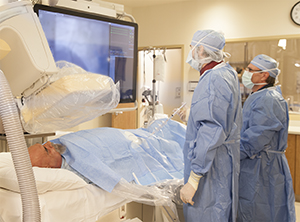Carotid Angiography
Carotid Angiography
Carotid angiography is a type of X-ray test used to view the carotid arteries. These are the large blood vessels that supply your brain with blood. During the test, a thin, flexible tube called a catheter is passed into an artery in the leg or arm that leads to the carotids. Contrast fluid is then injected through the catheter. The fluid makes it easier to see the carotids on the X-rays.
Talk with your healthcare provider about the risks and complications of angiography.
How do I get ready for a carotid angiography?
Tell your healthcare provider about any past or current health conditions
Tell your healthcare provider about any allergies you may have, including allergy to contrast dye.
Tell your healthcare provider about all medicines you take. You may be told to stop taking some or all of them before the test. Tell your healthcare provider about:
All prescription medicines
Over-the-counter medicines that don't need a prescription
Any street drugs you may use
Herbs, vitamins, kelp, seaweed, cough syrups, and supplements
Tell your healthcare provider if you are pregnant, think you could be pregnant, or are breastfeeding.
Don’t eat or drink after midnight the night before the procedure. If your healthcare provider says to take your normal medicines, swallow them with only small sips of water.
Arrange for an adult family member or friend to drive you home.
What happens during carotid angiography?
An IV line is started in your arm. You may also be given a medicine that helps you relax (sedative).
You’re given an injection to numb the site where the catheter will be inserted. This is usually the groin area.
A small puncture is made into the artery, and the catheter is inserted. Using X-rays, the catheter is then carefully guided through the artery.
Contrast fluid is injected through the catheter into the artery. You may feel warmth or pressure in your legs, back, neck, or head. You will need to lie still as X-rays are taken of the carotids. You may be asked to hold your breath during injections. When the procedure is complete, the catheter is removed.
What happens after carotid angiography?
You’ll be taken to a recovery area.
Pressure will be applied to the insertion site for about 10 minutes.
You’ll then need to lie flat for a few hours.
Your healthcare provider will discuss the results with you soon after the procedure.
Depending on your test results and your medical condition, you will either be discharged home or remain in the hospital.
Once you are home:
Don’t drive for 24 hours.
Don't walk, bend, lift, or take stairs for 24 hours.
Don't lift anything over 5 pounds for 7 days.
Be sure to follow any other instructions from your healthcare provider.
When should I call my health care provider?
Call your health care provider if you have any of the following:
Fever of 100.4°F (38°C) or higher lasting for 24 to 48 hours, or as advised by your health care provider
Bleeding, swelling, or a lump at the insertion site
Sharp or increasing pain at the insertion site
Dizziness or lightheadedness
Leg pain, numbness, or a cold leg or foot
Severe headache, visual problems, or trouble speaking
Any other symptoms your health care provider gave you to report based on your medical condition
Updated:
December 30, 2017
Sources:
Evaluation of carotid artery stenosis. UpToDate.
Reviewed By:
Fraser, Marianne, MSN, RN,Grossman, Neil, MD,Image reviewed by StayWell art team.
